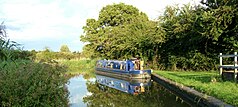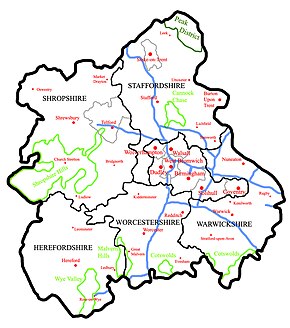
A | B | C | D | E | F | G | H | CH | I | J | K | L | M | N | O | P | Q | R | S | T | U | V | W | X | Y | Z | 0 | 1 | 2 | 3 | 4 | 5 | 6 | 7 | 8 | 9
This article needs additional citations for verification. (March 2022) |
West Midlands | |
|---|---|
From top, left to right: Birmingham; Coventry; Malvern Hills; the Wrekin; Trentham Estate; Shakespeare's Birthplace; Droitwich Canal | |
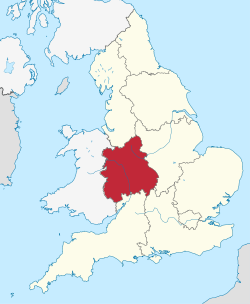 West Midlands, highlighted in red on the map of England | |
| Coordinates: 52°28′43.9″N 2°15′22.7″W / 52.478861°N 2.256306°W | |
| Sovereign state | United Kingdom |
| Country | England |
| Combined authorities | West Midlands |
| Districts | |
| Counties | |
| Government | |
| • Type | Leaders' board |
| • Body | West Midlands Councils |
| • House of Commons | 59 MPs (of 650) |
| Area | |
| • Total | 5,021 sq mi (13,004 km2) |
| • Land | 5,019 sq mi (12,998 km2) |
| • Water | 2 sq mi (5 km2) |
| • Rank | 7th |
| Population (2021)[2] | |
| • Total | 5,954,240 |
| • Rank | 5th |
| • Density | 1,190/sq mi (458/km2) |
| Ethnicity (2021) | |
| • Ethnic groups | |
| Religion (2021) | |
| • Religion | List
|
| GSS code | E12000005 |
| ITL code | TLG |
| GVA | 2021 estimate[4] |
| • Total | £146.1 billion |
| • Rank | 6th |
| • Per capita | £24,530 |
| • Rank | 6th |
| GDP (nominal) | 2021 estimate[5] |
| • Total | £164.6 billion |
| • Rank | 6th |
| • Per capita | £27,649 |
| • Rank | 7th |
| This article is part of a series within the Politics of the United Kingdom on the |
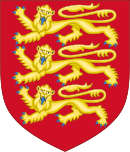 |
|---|
The West Midlands is one of nine official regions of England at the first level of International Territorial Level for statistical purposes. It covers the western half of the area traditionally known as the Midlands. The region consists of the counties of Herefordshire, Shropshire, Staffordshire, Warwickshire, West Midlands and Worcestershire. The region has seven cities; Birmingham, Coventry, Hereford, Lichfield, Stoke-on-Trent, Wolverhampton and Worcester.
The West Midlands region is geographically diverse, from the urban central areas of the West Midlands conurbation to the rural counties of Herefordshire, Shropshire and Worcestershire which border Wales. The region is landlocked. However, the longest river in the UK, the River Severn, traverses the region southeastwards, flowing through the county towns of Shrewsbury and Worcester, and the Ironbridge Gorge, a UNESCO World Heritage Site. Staffordshire is home to the industrialised Potteries conurbation, including the city of Stoke-on-Trent, and the Staffordshire Moorlands area, which borders the southeastern Peak District National Park near Leek. The region also encompasses five Areas of Outstanding Natural Beauty, the Wye Valley, Shropshire Hills, Cannock Chase, Malvern Hills, and parts of the Cotswolds. Warwickshire is home to the towns of Stratford upon Avon, birthplace of writer William Shakespeare, Rugby, the birthplace of Rugby football and Nuneaton, birthplace to author George Eliot.
Geography
The official region contains the ceremonial counties of Herefordshire, Shropshire, Staffordshire, Warwickshire, West Midlands and Worcestershire.
There is some confusion in the use of the term "West Midlands", as the name is also used for the much smaller West Midlands county and conurbation which is in the central belt of the Midlands and on the eastern side of the West Midlands Region. It is also still used by various organisations within that area, such as West Midlands Police and West Midlands Fire Service.
The highest point in the region is Black Mountain, at 703 metres (2,307 ft) in west Herefordshire on the border with Powys, Wales.
The region contains five Areas of Outstanding Natural Beauty (AONBs), including the Shropshire Hills, Malvern Hills and Cannock Chase, and parts of the Wye Valley and Cotswolds. The Peak District national park also stretches into the northern corner of Staffordshire.
Towns and cities
Major towns and cities in the West Midlands region include:[6]
- Bold indicates city status.
Urban areas
The West Midlands region contains several urban areas with populations of 100,000 or more in 2021, which include:[7]
- West Midlands conurbation (includes Birmingham, Wolverhampton, Solihull, Sutton Coldfield, Dudley, West Bromwich and Walsall.) (Pop: 2,594,803)
- Coventry and Bedworth urban area (includes Coventry, Bedworth and Binley Woods.) (Pop: 389,603)
- Stoke-on-Trent built-up area {includes Stoke-on-Trent, Newcastle-under-Lyme and Kidsgrove) (Pop: 382,687)
- Telford (Pop: 161,170)
- Worcester (Pop: 107,082)
- Royal Leamington Spa Built-up area (includes Leamington Spa, Warwick, Whitnash, Cubbington) (pop: 102,972)
- Nuneaton built-up area (includes Nuneaton, Bulkington, Hartshill} (pop: 100,710)
Modern history
Second World War
The RAF Fauld explosion on 27 November 1944 in east Staffordshire produced a 100-foot deep crater, and is the UK's largest explosion, being caused by around 4,000 tonnes of high explosive, and may be the world's largest non-nuclear explosion.
Birmingham was the third most bombed city in the UK after London and Liverpool; Spitfires were built in Castle Bromwich, Lancasters at Austin's works in Longbridge at Cofton Hackett, and the Birmingham Small Arms Company at Small Heath produced the M1919 Browning machine gun. Boulton Paul Aircraft had their main aircraft factory in the north of Wolverhampton. RAF Defford, in the south of Worcestershire between Pershore and Croome Park, was where many important airborne radars were developed, such as H2S (radar) and anti-submarine radars.
Scientific heritage
Thomas Wedgwood, son of Josiah Wedgwood, discovered the first photo-sensitive (light-sensitive) chemicals – silver nitrate and silver chloride in the 1790s.
Sir Norman Lockyer of Rugby discovered helium in 1868, for which he used electromagnetic spectroscopy.
Edward Weston of Oswestry, who emigrated to the US, built the first accurate voltmeter in the late 1880s, and the Weston cell in 1893.
Francis W. Aston of Harborne, educated at the University of Birmingham, developed mass spectrometry in 1919, which helped him to identify the first isotopes, receiving the Nobel Prize for Chemistry in 1922.
Dennis Gabor invented holography at British Thomson-Houston in Rugby in 1947, receiving the Nobel Prize for Physics in 1971.
James Glaisher in 1862 took a record balloon flight with Henry Tracey Coxwell for the BAAS near Wolverhampton. They reached 29,000 feet (8,800 m) the composition of the Earth's atmosphere until then was not understood; the altitude records for the UK have not been exceeded since; Project Excelsior in the US in 1960 would later reach 20 miles (110,000 ft).
Philip Lawley of Burton upon Trent was first person to realise that chemical damage to DNA caused cancer (at the Chester Beatty Research Institute in London) in the early 1960s.
Francis Galton (d. 1911) of the Darwin–Wedgwood family's Birmingham branch was an early eugenicist rooted in improving animal breeding stock and examining heredity. He invented terms eugenics and nature versus nurture. His limited calls for human eugenics were widened by the German Society for Racial Hygiene in 1905 founded by Alfred Ploetz, which coupled with the racial superiority fallacies of Aryanism reached its nadir in genocidal antisemitism. Moral teachings and inherent repulsions towards human eugenics were overcome by a minority of those in power espousing racial equality; European media and leaders lamented loss of Empire, advocated ultranationalism and prized military physical advantage; Galton saw human eugenics as part of all means to do better.
Industrial heritage

Much of the Industrial revolution in the United Kingdom began in Birmingham and the Black Country area of West Midlands. The Industrial Revolution is thought to have begun when Abraham Darby substituted coke in the place of charcoal to smelt iron, at his Old Furnace. The Black Country may be regarded as the world's first industrial landscape,[8] while nearby Ironbridge Gorge claims to be the Birthplace of Industry.[9] The world's first cast iron bridge in 1779 spans the Gorge. The first self-propelled locomotive to run on rails in 1803 at Coalbrookdale, was built by Richard Trevithick. The first iron rails for horse-drawn transport, were made at Coalbrookdale in 1768 by Richard Reynolds at Ketley Ironworks. Iron rails only became widely successful in 1820 when made out of wrought iron at Bedlington Ironworks in north-east England.

Birmingham's industrial development was triggered by discussions at the Lunar Society of Birmingham at Soho House, Boulton's house, and products were carried along the BCN Main Line canal. Soho Manufactory was the first man-made-powered factory in world. Chance Brothers of Smethwick built the glass for The Crystal Palace in 1851. Smethwick Engine, now at Thinktank, Birmingham Science Museum, is the oldest working steam engine, made in 1779, and is the oldest working engine in the world. Smethwick was a main centre for making lighthouse lanterns.
Valor Fires in Erdington developed the first radiant gas fire in 1967, a balanced flue fire in 1973, and a natural flame gas fire in 1978. The Erdington site, owned by Iceland's BDR Thermea, closed in May 2012. The company also built gas cookers; since 2011 the company has been part of Glen Dimplex, who have a site at Cooper's Bank, south of Gornalwood.
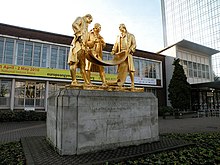
Ditherington Flax Mill in Shrewsbury was the first iron-framed building in the world in 1797. Thomas Bolton & Sons of Froghall, Staffordshire, made the world's first transatlantic telegraph cable in 1857, having supplied a submarine cable across the English Channel in 1850. On 10 July 1890, a trunk circuit telephone line was opened between London and Birmingham by the National Telephone Company; for the first time this allowed phone calls between the London and the north.[10] The world's first coaxial cable was laid between London and Birmingham in 1936 to give 40 channels for telephone traffic.[11] and brought into use in 1938, later extended to Manchester in 1940.
Alexander Parkes invented the first man-made plastic (thermoplastic) in Birmingham in 1856. Princess Square, Wolverhampton, was the site of Britain's first traffic lights in 1927. Infrared cameras were developed at the Royal Radar Establishment in Malvern (with EMI Electronics) in 1967. The world's first Maglev train operated at Birmingham Airport in 1983. The tallest freestanding structure in the region was the chimney of Ironbridge power station at 673 ft. John Baskerville of Birmingham, a former stone carver, largely invented fonts, or typefaces, for printing.
Much of the UK's car industry would be centred in Coventry and Birmingham; most of this has now gone. Midland Motor Cylinder (part of Birmid Industries) of Smethwick was the largest producer of automobile cylinder blocks in Europe. Fort Dunlop was Europe's largest tyre plant. Metro-Cammell in Birmingham made most of the 1970s and 1980s London Underground trains. MG Rover (a company of Rover) closed in 2005 (from 1885), The Ryton plant, which made the Peugeot 206, closed at the end of 2006, with production moving to Trnava in Slovakia, and some to a plant at Kolín in the Czech Republic. Alfred Herbert of Coventry was the largest machine-tool manufacturer in the UK for many decades; it was brought down in the 1970s by advancing technology overseas, and complacent strategic decisions of the management, finally closing in 1982; many Midlands manufacturing companies followed similar fates in the 1970s and 1980s.
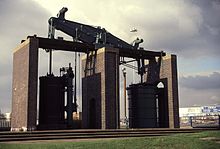
Henry Wiggin & Co of Hereford developed the metal alloys necessary for other Midlands' (and beyond) automotive and aerospace companies – Inconel, Incoloy and Nimonic. It was the lack of vanadium for high-melting point alloys, caused by Royal Navy action, that prevented German Me 262 engines being serviceable; had German Second World War engineers had a greater supply of vanadium and molybdenum, the engine life (around 12 hours maximum, from entering service in April 1944 to the end of the war) of their jet engine would have increased much more, which would have been significant to the war's outcome. Bristol Siddeley developed the rocket engines for Black Arrow at Ansty; in fact all of R-R's rocket engines were developed and built there at R-R's Industrial and Marine Gas Turbine Division; Britain's smaller rocket engines for missiles were built by Bristol Aerojet in what is now North Somerset. High Duty Alloys at Redditch constructed (forged) the compressor and turbine blades for Whittle's first engines, and many of the early jet engines; it made Concorde's airframe from the Hiduminium R.R.58 aluminium alloy.
Maxaret, the world's first ABS braking system, was invented in Coventry by Dunlop in the early 1950s for aircraft; John Boyd Dunlop was a Scottish vet who had first produced the first pneumatic tyres in 1889. Matthew Piers Watt Boulton, grandson of Matthew Boulton, and born in the area, invented the aileron, an important flight control surface in 1868, decades before the first actual flight. Triumph Engineering was a famous motorbike firm in Meriden. About a quarter of all British WWI planes were built in Coventry. The Jensen Interceptor FF was the first production four-wheel-drive car in the world, designed by Major Tony Rolt, and built at their factory in West Bromwich.
Cadbury launched Dairy Milk in 1905, Bournville in 1906, Fruit & Nut in 1928, Whole Nut in 1930, Cadbury Roses in 1938, and the Cadbury Creme Egg in 1971. George and Richard Cadbury built their factory in 1879 and Bournville in 1893, named after the Bourn brook. Iceland (supermarket) opened its first store in Oswestry in 1970 – heralding the onset of frozen food in the UK. Alfred Bird invented egg-free custard in 1837 in Birmingham – accidentally given to guests at his home, being created as his wife had an allergy to eggs; he then invented baking powder in 1843 as his wife also had an allergy to yeast.
Culture
J. R. R. Tolkien grew up in Birmingham, Kings Heath, then part of Worcestershire, and was inspired by Moseley Bog and Sarehole, and perhaps by the Perrott's Folly. Philip Larkin came from Coventry. Rowland Hill (stamps) was from Kidderminster. The writer George Eliot came from Nuneaton. Anthony E. Pratt from Birmingham invented Cluedo.
Frederick Gibberd of Coventry designed Liverpool Metropolitan Cathedral. Edward Cave from Rugby made Britain's first magazine in 1731 – The Gentleman's Magazine. Philip Astley from Newcastle-under-Lyme invented the modern day circus in 1768 – Astley's Amphitheatre.
The Castlemorton Common Festival in May 1992 near Malvern, led to the Criminal Justice and Public Order Act 1994.
The Nowka Bais is a Bengali boat racing festival which takes place annually in Birmingham. It is a cultural event in the West Midlands, United Kingdom attracting not only the Bangladeshi diaspora but a variety of cultures.[12] It is also the largest kind of boat race in the United Kingdom.[13]
Regional assembly
The official representative body of the region is the West Midlands Leaders Board which has limited administrative functions such as regional planning and economic development. The board is not an elected body, but is made up of members appointed from local councils across the region and is known as a quango. It is based on Edward Street in Birmingham, near the National Indoor Arena. From March 2010, the funding decisions at regional level were taken over by Advantage West Midlands, the Regional Development Agency.
Demographics
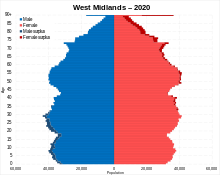
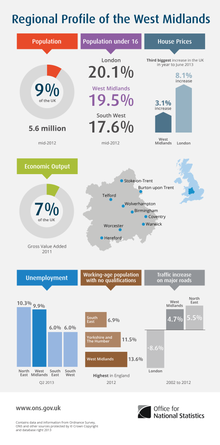
Ethnicity
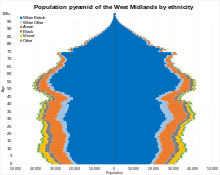

The West Midlands is the second most ethnically diverse region of the UK (London being the most diverse). This is in large part due to the West Midlands conurbation, which is highly diverse. The ethnic makeup of the West Midlands as a whole as measured by the 2011 census was as follows:







